Plectron Corporation encoder information and tone archive

Dedicated to Plectron users nationwide by keeping the memories alive!
Last Update - 5/23/2018

This page is a work in progress - it's intended to provide basic information about the Plectron Corporation's encoder product offerings, some basic history of the company, host scanned product information pages, and let you listen to some example sound files. I collect old Plectron tone encoding equipment and find there's almost no information left on the Internet about the company and their products. This page is my little historical contribution to fill some of the information void.
- A QUICK & SIMPLE PLECTRON HISTORY
- Plectron is a very interesting company, actually bridging three technology levels in modern history in providing public safety alerting technology. Those are... Vacuum-tube based analog, solid-state (transistor) analog, and solid-state digital alerting technologies. As far as I know Plectron never marketed an original product using SMD's. Only Motorola can provide the same level of continuity that I'm aware of today (I'm not counting General Electric/Ericsson/Com-Net/ M/A-Com / Harris since that company has been purchased over & over again over the years and doesn't retain the same corporate identity). To provide you with some quick basic history, the following site has an excellent chronology of Plectron - better then I could ever compile. As I have no desire to plagiarize anyone's material, take a quick read here and come back when you are done (linked with permission of site owner).
Plectron corporate history by Wallace Radio
- PLECTRON ENCODER PRODUCTS
The smaller encoder for fire station dispatch office use (up to four calls plus pulsed alert) was the model G21. A Model G22 was available for use in a car, it was a takeoff on the G21 encoder, powered by 12VDC.
Plectron's version of an emergency backup for their encoders was a thing of beauty. TUNING FORKS sold in the exact tone frequency that was needed to set off your department's alerting receivers. For a single tone alert the procedure was very simple, you struck the tuning fork & held it up to your microphone for 10 seconds or so and then gave your dispatch. Duotone combinations were a little harder (yes, two tuning forks were involved which needed to be struck in the correct sequence). Dispatchers prayed they never had to go to backup if their encoders went down!!
One of the classic encoders of all time was the Plectron Model G2 vacuum tube-type encoder. This was available in either an 8 or 16 button configuration, with a cam and motor for tone timing (either steady or interrupted - pulse) and a LIGHTBULB used to regulate voltage on the tones. It was built like a tank! This encoder was manufactured from the 1950's on into the late 1960's - early 1970's. Another encoder, very rare, was the Plectron G5 encoder, this was a single or dual-tone encoder with an on-off switch that was designed for mobile use (from a Fire Chief's car for instance). I found one on an EBAY auction in November, 2017 which I promptly purchased, the one I have is a dual-tone unit. I'll put up a few pictures of it soon.
Later on in it's history, Plectron (through WEI) entered into business relationships with Federal Signal, their final encoder line was basically built on top of another encoder platform as their G25 encoder - this unit was the replacement for the G8 and G21 series and was internally dip switch programmable. The desktop encoder was available in either a five code (G25-5) or an eighteen code (G25-18) configuration. The G15 console mount encoder was also offered for dispatch centers with console furniture, and was available in either a 20, 40, or 60 code configuration. These encoders were offered starting around 1990 until the remaining business of the company was absorbed by Federal Signal.
- G8 ENCODER PICTURES

- This is a Plectron G8 twenty-call encoder, taken from the front of the basic control head. This encoder supported up to twenty (20) separate page calls. The "alarm" button sent either a pulsed 1000hz tone or a distinctive "warble" tone (depending on how the encoder was optioned, seen them come from the factory both ways). The encoder could be ordered with either automatic (warble/alert after each tone sequence) or manual alarm (manually triggered by the "alarm" button on the panel to allow for multiple pages with only one alarm. Also an option that could be ordered/wired is "automatic alarm cancel", this allowed the automatic alarm to be wired on a per-button basis. Certain codes could be transmitted no alarm (for instance test codes or siren codes), while other codes could trigger the alarm (an all call for example).
- Other encoders of this type were the Plectron G6A and the G7B or G7C. The G6 was a singletone encoder, the G7 a duotone encoder with either a common "A" or "B" tone depending on how it was ordered. Both were usually ordered in a 10 button head configuration. All three encoder types in this series did have the capability of manual alarm. During the 1970's the G6 and G7 series encoders were discontinued in favor of the G8D.

- Longer shot of the G8 head. Note the large multi-conductor cable & jones plug attaching the head to the encoder

- A better shot of the male Jones plug.

- A shot of the tone chart on the rear of the remote head. This chart told you what tone was programmed to each button on the encoder. Important road map to have.

- For all you folks that complain about modern encoder programming (like the Zetron Model 25), you DON'T KNOW HOW EASY YOU HAVE IT. This encoder is programmed via diodes and soldered wires, and ALSO a slide-on tone matrix for things like reversing calls, tone timing, etc..

- A closer shot of the back of the head. Note the slide-on matrix in the top of the head.

- A closer shot of individual button programming. Note the several diodes per button, this commanded which boards were accessed to make your "A" and "B" tone, also whether the timing was short or fast duotone or single tone, reverse, etc... Multiple diodes (as seen here) could be soldered on per plastic button. And... don't leave the iron on the button contactor too long or you could melt the button which meant replacing it and starting over. Also note the extensive use of heatshrink and rigid insulator tubing. Stuffing all the wires back in the small case for the remote head meant sometimes things did move around a little, unless you took these kinds of precautions you might have wires contacting undesired wires, which leads to a long troubleshooting day for you - especially on intermittent failures!
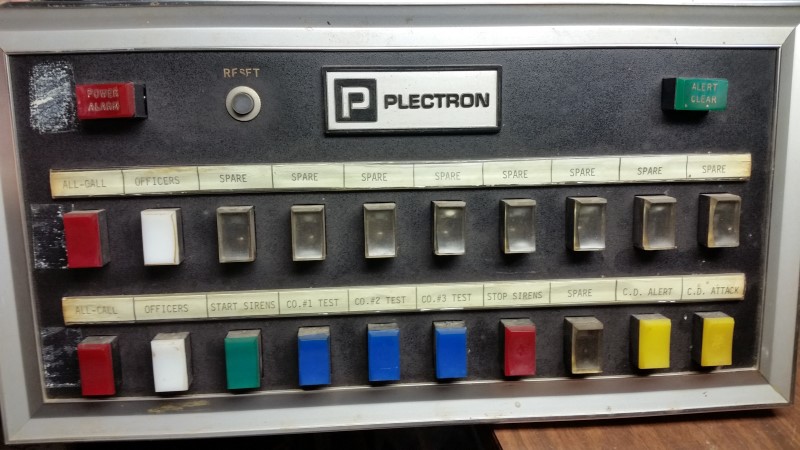
- This is the twenty button (actually twenty-two button) lit G8 encoder head. This was a higher-end head and is relatively rare. This is the only one I've ever had my hands on, prior to this I've only seen one in Plectron product literature.
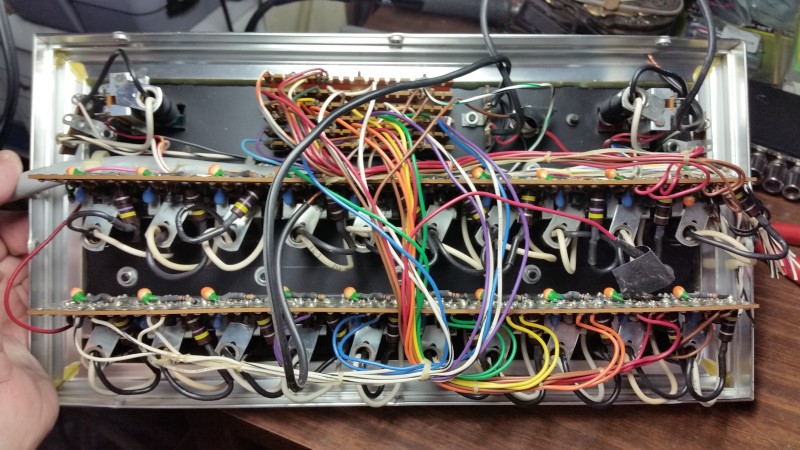
- The rear of this head is a nightmare. It uses the same 10-button units as found as the 50 and 100 button encoders, except oriented 90 degrees opposite. It also takes an external AC power supply, the manuals are extremely vague on the proper operating voltage, I'm going to try as 12VAC power cube soon and see what happens. The lights are 8192 bulbs, 14.4 VDC. In this head, eight bulbs in a row of ten were burned out. It's extremely difficult to change bulbs, which is probably the reason why. The small "reset" button on the front of the encoder resets bulbs that are lit. There is a nice metal case held on by many screws that I've removed for the picture of the inside hardware along with a tilt-able bracket to adjust angle. Same multi-conductor plug that a regular G8 encoder uses goes to the encoder body, and same programming matrix in the upper-center portion of the head.

- This is the standard G8 encoder, unrestored, front view. Not much to look at from this angle, just a black metal box with a namebadge.

- There's more to look at in this picture of the rear of the encoder. This is a 1978-era encoder. note the big doorbell-sized reset button, the large female Jones plug which interfaced with the control head plug shown above, the 4-pin Jones plug as J2 which was the keying & audio out, the special four-pin UL power connector (very rare to find if you lose one BTW), and the three test switches for tone calibration. Pots were provided with outside screwdriver access to adjust modulation and internal speaker volume for operator feedback.

- Botttom of the encoder. This wasn't much to look at, however it contains the tone chart that translated the "A" and "B" tone positions into slot locations on the inside of the encoder. Important information to have although the individual tone boards are almost always marked as far as tone frequency, as you'll see in a moment. This encoder is set up for Duotone, the "A" tone has a 992hz board in slot 1, 871hz board in slot 2, and a 910hz board in slot 3. The "B" tone translates according to the chart with 8 possible tones. Also you can see the property tags, this encoder came from the Portland, CT Fire Department - I won it on a govt. on-line auction sale in April, 2016.

I'd bet right now that your first look at the inside has you thinking "OH MY GOD!". Welcome to solid-state tone alerting ala 1972. As you can see, each tone has a separate plug-in circuit board as do the three timing intervals for the tones. Timing on the top row, then "A" tones, then "B" tones. Power supply board on the right, feedback speaker on the left, amplifier boards, alarm board, three motherboards, boards for all occasions in this puppy!

- Plug-in tone board. Plectron defined tone frequencies by using mica (gumdrop) capacitors, look to the right of the potentiometer and you'll see two capacitors. The board could contain up to four capacitors that set the tone frequency according to a pre-defined chart. Solder in the correct caps, then zero-beat the tone frequency against a tuning fork or audio generator using the test switches on the outside of the encoder to activate the tone in a hold mode. These boards were very good on not drifting, only occasional touch-up was required.
- Plectron provided service shops their Model 95 tone generator (variable sweep audio oscillator with short-range scales) to set tones with, here's what one looks like. This unit came out with the G2 encoders, but was used also used with both the later model G8 and G21/G22 encoders.


- Here is a close up of the "B" tone row. Each board plugged into the proper slot that translated to the diodes & wiring positions on the programming matrix in the control head (pictured earlier). Plectron sold a board extender used when you did your frequency alignments, you used it one board at a time. Another trick was to pull all tone boards out except the one you were setting the frequency on, but that meant a lot of plugging and unplugging of modules. Naturally since the contacts were a box-pressure fit onto the circuit board fingers, you tried to minimize board removal/inserting as much as you could. Eventually the contacts could wear out with repeated motion and you either had to use pliers to crimp the metal back down, or install new contacts. Thankfully this didn't happen very much.
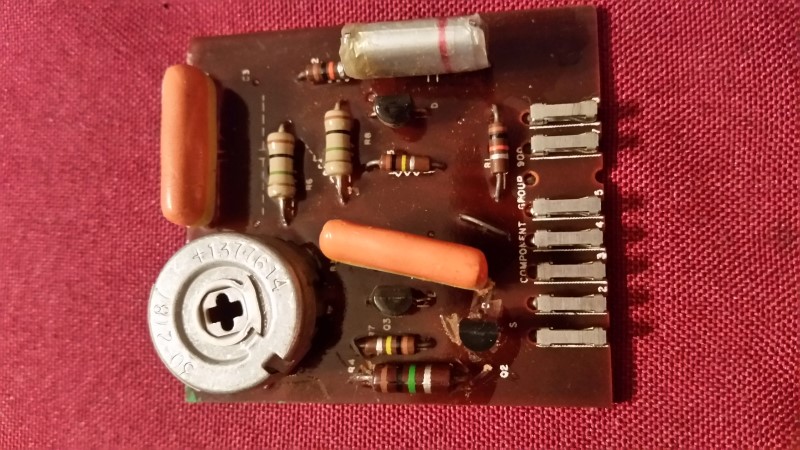
- This is a timing module. The timing components were variable, again through the use of soldered-in components anywhere from .25 seconds to 20+ seconds. You could have three timing modules and one reversal module in the timing section.

- This module generates the famous Plectron Warble or "alarm tone", the swept siren activated at the end of a series of calls either automatically or by pushing the "ALARM" button on the encoder head. This was actually an add-on option, if you didn't buy the board Plectron configured the encoder to pulse the "A" tone 7 times after each tone button was pushed, and provided a small module for pulsed 1000hz when you pushed the "ALARM" button for as long as the button was held down.
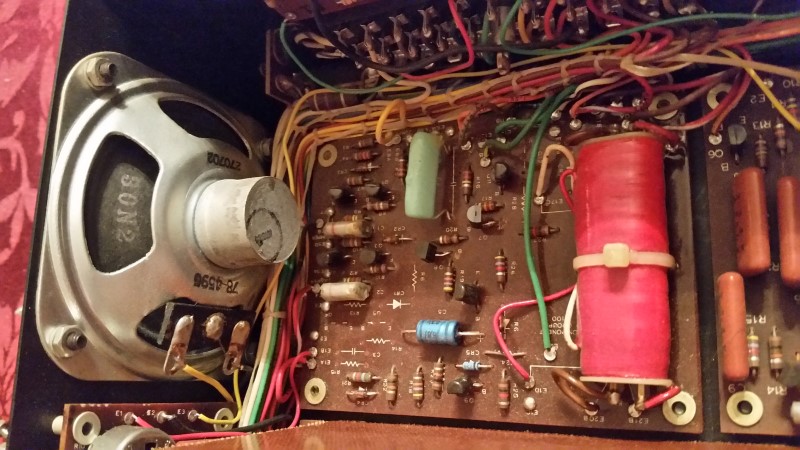
- Left rear side of the encoder viewed from the front. Of note here is the red reed-type keying relay. These occasionally do fail, if it does the encoder might provide tones on the audio line but you won't see TX keying. Also is a speaker driven by a small amplifier, this was for technician/dispatcher audio feedback to let them hear a little something out of the encoder that confirmed that tones were going out.

- Right rear side of the encoder, power supply section. Two glass fuses, after lightning strikes or power surges if your encoder is dead this required opening the case and checking both fuses. Plectron should have wired these encoders such to have outside fuse access, this would have reduced the amount of case openings necessary. But they did not design like this for whatever reason. Also in looking at these circuit boards note a few things.... you do not see IC's anywhere, this encoder was designed in the very early 1970's when IC's were not as of yet in common use. Again, this encoder dates from 1978. Also, note the lace cord used to bundle wires together to form harnesses. This was commonly seen in aircraft & space capsules, also in computers of the day. You formed a certain skillset tying the laces & making nice knots when you used this cord. Master craftsmen at work here folks. I should mention Plectron also had their own metal shop, all their cases, panels, etc.. were made in-house up until the time they went plastic with some of their home receivers in the middle of the 1980's.

This is a different encoder that was manufactured three years later (1981). This G8 encoder was used with the lighted 20-button remote head, note the extra board to the left of the alarm board. I put this picture in for comparison purposes, the same design was used until roughly 1989-1990 when the G25/G15 series of encoders were released.
-
One more picture that was recently contributed courtesy of Nate Scott (Thanks Nate!) is of a old Plectron G6 encoder head that was found surplus in a firehouse. This encoder had a 1972 production date and was single tone only on Button #1.
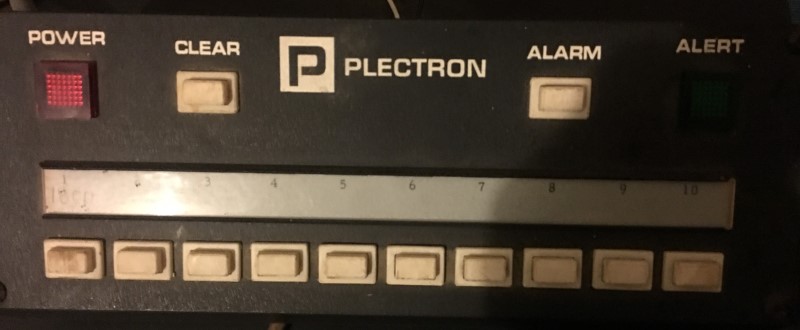
- G21 ENCODER PICTURES
- The following are some pictures of the Plectron G21 encoder. This was a smaller unit, typically used for calling out only 1 or 2 fire departments as it would handle four codes maximum. Single tone or duotone, slow or fast tone timing, but no warble alert. The "A" tone was usually pulsed five times after each alert was sent with this unit. The Model G21A would do single tone only, one to four tones. Model G21B would do Duotone, second tone common. Model G21C would do Duotone, first tone common.

- The basic G21 encoder, unrestored. Up to four buttons, mixed calls were allowed.

- Back of the encoder. Plug J1 was for audio & keying output, J2 was for a remote head. Two switches for remote tone adjustment. 110 VAC power delivered via a funky plug, the plug could also be used for 12VDC in to power the encoder as well. And the necessary tone chart from the factory.
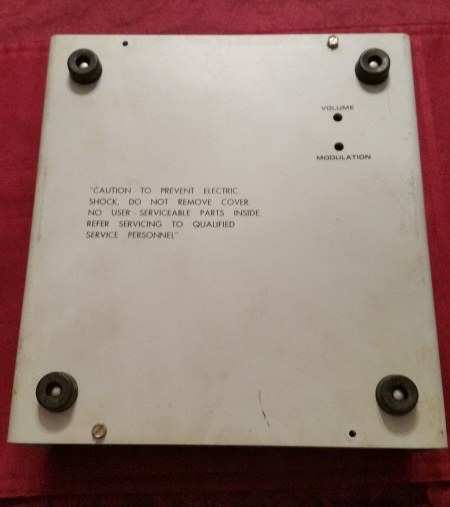
- Bottom of the encoder. Pretty plain, volume for the internal speaker and a master modulation out adjust were located here, long screwdriver was necessary to make the adjustments.

- Inside the encoder after removing the bottom case. Main motherboard/output board, tone timing, etc... are all found here.

- Second board after flipping up the hinged support. Boards that dictate the tones are located here. Plectron uses gumdrop capacitors to set tone frequencies. Power supply board is the smaller board on the left.

- Transformer, back of the female end of the jones plugs, wiring up to the motherboard.

- Back of the four push switches, bulb sockets (yep, no LED's on this baby for indicators!), harnessing. Note the extensive use of lace cord to tie everything together. These encoders were built like a Sherman tank. Unless lightning got them, they were generally trouble free and lasted a very long time. The yearly FCC check was usually good enough to make sure the tone frequencies hadn't drifted and that modulation was correct. And, if the tones did drift slightly there were adjustment pots to compensate.
G2 ENCODER PICTURES

- This section documents the Plectron Model G2 encoder, models G2A, B, C, D, and E. The Plectron G2 was used for alerting at fire stations across the US, Volunteer Police Departments, Rescue Squads, anytime there was a need to page personnel via tone alert receivers.
The Plectron G2A encoder I've documented for you today comes courtesy of the Cocoa, FL Fire Department, it was one of two encoders their department owned. The network was decommissioned in the very early 1990's, I purchased this encoder for $1.00 at the Cocoa city auction in, I believe, 1991. I'm very glad I saved this example G2 from the electronic junkpile, I had it on display along with a Plectron Sentry receiver in my County office until mid-2006, then I had it stored in a bankers box in secure, climate control storage for the next ten years until 2016. When I dusted it off the other day, I cleaned contacts with Caig Laboratories DeOxit, made sure the mechanisms all worked and were lubricated, then I plugged the unit in on a leap of faith and let it rip! The encoder fired off as well as it did when it was in-service. Considering it had a build date of 1964, 52 years worth of storage and service is something you NEVER see any more. And, when I checked the tone frequency for Channel 1, it was within 1hz of where it was originally supposed to be 52 years ago. If that's not a product testimonial, I don't know what is!!
- Going through the five different models, a G2A encoder was singletone only, up to 8 possible tones (16 with second row of buttons - optional). Model G2B was duotone, second tone common. Model G2C was duotone, first tone common. Model G2D was mixed single/duotone, buttons on the left were singletone, buttons on the right were duotone. Model G2E was selectable duotone with up to 64 different tone combinations (8 possible A tones, 8 possible B tones). All encoders could be ordered with either 8 or 16 buttons (Standard on G2E). The encoder documented here is a very basic model G2A, one oscillator, originally ordered with one tone. Tones 2 and 3 were field-added at a later date.

- My Plectron G2A encoder. 8 tone capable, 1 tone originally installed, two tones field-added at a later date.
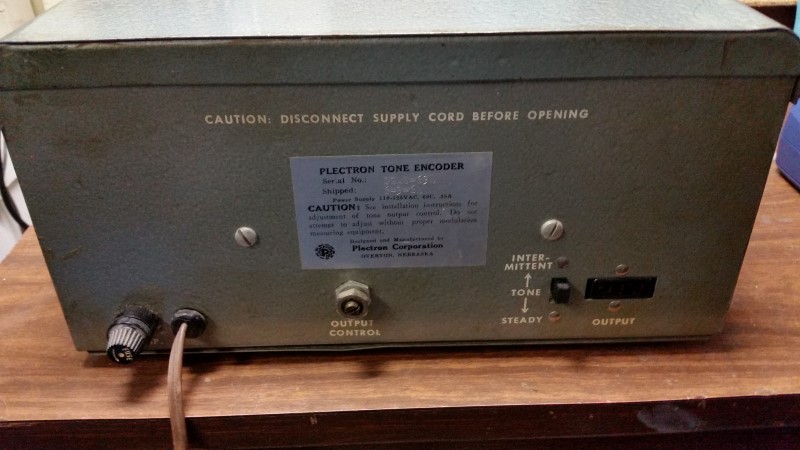
- Rear of the encoder. Three wire jack for output, standard 110V 2-wire cord for AC input.

- Closer shot of the serial plate showing the 1964 build date. Also note the steady/intermittent alert selection switch.

- Bottom of the encoder. Tone adjustment pots were located here. Each separate tone could be varied + or - 25hz with the pot, adjustment was usually made via a zero-beat audio source and using the trimming pot in conjunction with the speaker. Plenty of audio for the tech/dispatcher to hear positive feedback from the encoder.

- A little homage to the contributing agency, Cocoa Fire Department, Cocoa, Florida.
 The inside of the unit. Note the two vacuum tubes AND the light bulb. The light bulb never lights, it's there solely as a part of the circuit. The service manual specifies this technical description of the unit (reproduced verbatim);"A 12BH7 dual triode operates as a Wien bridge oscillator. This circuit consists of a two-stage resistance coupled amplifier, utilizing both positive and negative feedback... The operating level of the oscillator is determined by the 5K feedback control, R4 single tone, R4 and R21 duotone. A part of the feedback network consists of the three watt lamp, V3 single tone, V3 and V5 duotone, which operates as a non-linear resistor so as to hold the output voltage of the oscillator at the constant value determined by the feedback control. Frequency selection is accomplished by manually switching the correct precision capacitors in the oscillator circuit."
The inside of the unit. Note the two vacuum tubes AND the light bulb. The light bulb never lights, it's there solely as a part of the circuit. The service manual specifies this technical description of the unit (reproduced verbatim);"A 12BH7 dual triode operates as a Wien bridge oscillator. This circuit consists of a two-stage resistance coupled amplifier, utilizing both positive and negative feedback... The operating level of the oscillator is determined by the 5K feedback control, R4 single tone, R4 and R21 duotone. A part of the feedback network consists of the three watt lamp, V3 single tone, V3 and V5 duotone, which operates as a non-linear resistor so as to hold the output voltage of the oscillator at the constant value determined by the feedback control. Frequency selection is accomplished by manually switching the correct precision capacitors in the oscillator circuit."One other interesting narrative I was email'ed on how this circuit works was from Martin, a highly accredited site viewer... "This is a very cheap, reliable way to build an oscillator. The lamp sets the gain in the oscillator. It is not as well known as it once was, but tungsten lamps have non-linear resistance; the lamp resistance increases as the lamp gets hotter. In this application, the lamp is still very cold when the oscillator is up and running but not as cold as it was when the oscillator was first powered up. The lamp is set up to detect power (and therefore gain) in the oscillator, and provide feedback control to keep the oscillator operating in its linear, low-distortion, highi-stability range. This approach is not perfect. The lamp will exhibit microphonic distortion and respond to vibration or sound that mechanically excites the filament, and it sets lower and upper bounds on the frequencies you can generate. This approach is the one that Bill Hewlett wrote his dissertation on at Stanford, and the basis for the first product from Hewlett-Packard, an audio-frequency oscillator. All the surviving spinoffs of HP (Agilent, HP, and HPE) owe their existence to the money Hewlett and Packard made off that oscillator."
- Bob Wallace, owner of Wallace Radio told me in conversation that he's had many technicians over the years question how the light bulb (V3) works in the encoder when it doesn't ever light up! Plectron put the light bulb in place as part of the oscillator circuit, it's not supposed to light up. Ever. But, the encoder will not generate tones without it. It's the ultimate conundrum for the non-versed technician!

- Another shot of the interior of the unit, this time on the bottom side rear. Old-type direct wiring of components at work here, no PC boards in this vintage 1964 encoder.

- Front underside of the unit. Note the different style capacitors in positions 2 & 3, these tones were apparently a field add-on. Only one pot to adjust the tone and that was for Tone #1 as a factory build.

- The cam & switches. One switch operates the mechanism kick-over control to reset the tone selection at the end of the encoding cycle, the other acts as a tone interrupter so if you've got the rear toggle set to intermittent alert, the cam will pulse the tone on & off for four or five times at the end of an alert.

- The Plectron Sentry receiver on the top of the encoder was one of the receivers this device was designed to activate. This is an extremely clean example of a Sentry, formerly used with the Mims Volunteer Fire Department, Mims, Florida. It's also circa 1964, same as the encoder.

- And, just to show you I have the history on this encoder from it's original purchase, this is the maintenance manual obtained from the servicing radio shop, Datronics, Inc, Cocoa FL. This company is no longer in business, the shop owner gave me the manual in the early 1990's after I told him that I had purchased the encoder. He didn't need it any longer since the system was retired and he didn't have to maintain it.
- The following two links are movie files (appx. 65mb each, MP4 files) of the encoder generating tones. Be aware if you have a slow conection these might be a long download. It is really neat to see the encoder generating and watching the mechanisms working, the movies were both shot from the bottom of the unit. You have to admire the design expertise of the engineering staff at Plectron. I'd also like to note that I did NOT originally put the duct tape in the encoder. Whoever did the mod for tones 2 & 3 apparently installed it so as not to let anything short to the case. Since it was a part of the encoder's operating history, I merely put a new piece of duct tape in place of the old. Expert restorations clean & renew... to a point. What a classic firehouse mod on the fly!
Plectron G2A encoder, singletone alert generation, pulsed tone
PLECTRON LITERATURE
The following are scanned copies of various promotional literature that Plectron gave to interested customers. In some cases this may be the sole remaining copies of information on these product lines available on the Internet. It's very difficult to locate old product brochures, much less get them scanned to make them readily available to the on-line population.
Plectron dealer application package, circa 1990.
Plectron Encoder line brochure circa 1978.
Plectron Encoder line brochure circa 1981, including price list.
Plectron general products line brochure circa 1979.
Plectron general products line brochure circa 1990. This is after Woodson took over the company.
Plectron alerting and general product line brochure circa 1991, this is around the time Federal Signal acquired interest.
Plectron's general warranty circa 1978.
PLECTRON TONES
- Following are some examples of Plectron alerts from off-air recordings, actual encoders I own, etc... More content to shortly follow.
Plectron Alarm Warble, directly off a G8 encoder. Good quality! | Brevard County Disaster Plectron 1985-1995, G8 encoder | Same Disaster Plectron alert test, this time manually encoded | Four Communities VFD, G2 encoder | Bellwood VFD, G2 encoder | Brevard County District 4 Fire Dept., G2 encoder | Melbourne Beach VFD, G21C encoder | Micco VFD, G8 encoder | Titusville FD station alert, G8 encoder | Titusville FD personnel recall (Code 22), G8 encoder | Volusia County FD, alert for Station 6, G8 encoder. | Unknown low-band agency alert 1, G8 encoder | Unknown low-band agency alert 2, G8 encoder | Unknown low-band agency alert 3, G21 encoder |
TECHNICAL INFORMATION ON PLECTRON TONES AND ENCODING FORMATS
Plectron's tones and encoding methodology has been confusing for a good many people. Here's a quick & simple compendium on all tones Plectron!
Plectron fast duotone combination: Tone "A" is 750ms, Tone "B" is 250ms. Tone sequences can be reversed if the reversal option was ordered for the encoder, G8 only.
Plectron slow duotone combination: Tone "A" is 3000ms, Tone "B" is 750ms. Again, tone sequences can be reversed if the reversal option was ordered for the encoder, G8 only.
Plectron single tone page: One tone, transmitted for either 3000ms or 6000ms. The old tube type encoders went for 10-12 seconds on calls depending on where the cam cut off the timing motor. Occasionally they stuck running and the tone went on-air until the encoder either quit/blew a fuse, the transmitter timed out, or the finals quit if there was no TOT. Don't ask me how I know this!! Also... when the encoder was transmitting, more often then not the dispatch mike was open as well. A few interesting conversations went on-air during tests! The rotating cam caused a button reset when the code was through with a double "CLUNK", from the mechanical drivetrain releasing the spring-loaded reset mechanism.
Plectron Tones can come in any of the following frequencies (all in Hz): 282.2, 294.7, 307.8, 321.4, 335.6, 350.5, 366, 382, 399.2, 416.9, 435.3, 454.6, 474.8, 495.8, 517.8, 540.7, 564.7, 589.7, 615.8, 643, 672, 701, 732, 765, 799, 834, 871, 910, 950, 992, 1036, 1082, 1130, 1180, 1232, 1287, 1344, 1403, 1465, 1530, 1598, 1669, 1743, 1820, 1901, 1985, 2073, 2164, 2260, 2361, 2465, 2575, 2688, 2807, 2932, 3062, 3197, 3339, and 3487 hz.
Plectron encoders could be ordered with any tone combinations, an example is a Plectron G8 ordered with Motorola Group 2 frequencies as a special order. We had one of those in Brevard County, FL at our EOC that set off Plectron R8000 radio receiver recorders - it was a 100 button lit encoder to boot. With a sequencer. The sound files for this encoder are in the sounds section.
WHERE CAN I GO TO GET MY ENCODER SERVICED OR FIND TECHNICAL DOCUMENTATION?
- Well, this is a conundrum on servicing of the Plectron OEM encoder units. There is no longer a dedicated service shop that is supporting the older Plectron encoders. The problem is that the precision components used in the older encoders are no longer easily available, there is almost no supply of spare boards to replace lightning-damaged units, critical components such as buttons, keying reed relays, etc.. are inventory-depleted and not available. Older units are just no longer cost-beneficial to repair given the plethora of modern programmable encoders.
- A decent radio shop, when provided with a manual MAY be able to work on your old encoders. Manuals are still somewhat available from time to time on EBAY. I don't believe either Butler National or Federal Signal support these units in any way or form even though they each have a portion of the intellectual property rights. My personal recommendation for an encoder to support the role these units played is to purchase a Zetron Model 25 paging encoder. Farm the old Plectron encoder out to the department museum if the repair is difficult or it gets blasted by lightning, it's more than earned it's gold watch!
- NOW... as far as home receivers, this business services Plectron receivers of the P1, P500, P700, P8000, PII, R15-20, R515-520, R715-720, and R8190-8200 models as well as Chief, Sentry, and Patrol models, AND has reconditioned receivers available for sale for VHF low/high bands and UHF. With a $42 flat rate labor on Plectron receivers, get your units fixed here;
His corporate website is at: Wallace Radio for further information.